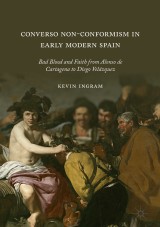Details

Converso Non-Conformism in Early Modern Spain
Bad Blood and Faith from Alonso de Cartagena to Diego Velázquez|
28,88 € |
|
| Verlag: | Palgrave Macmillan |
| Format: | |
| Veröffentl.: | 06.12.2018 |
| ISBN/EAN: | 9783319932361 |
| Sprache: | englisch |
Dieses eBook enthält ein Wasserzeichen.
Beschreibungen
<p>This book examines the effects of Jewish conversions to Christianity in late medieval Spanish society. Ingram focuses on these converts and their descendants (known as conversos) not as Judaizers, but as Christian humanists, mystics and evangelists, who attempt to create a new society based on quietist religious practice, merit, and toleration. His narrative takes the reader on a journey from the late fourteenth-century conversions and the first blood purity laws (designed to marginalize conversos), through the early sixteenth-century Erasmian and radical mystical movements, to a Counter-Reformation environment in which conversos become the advocates for pacifism and concordance. His account ends at the court of Philip IV, where growing intolerance towards Madrid’s converso courtiers is subtly attacked by Spain’s greatest painter, Diego Velázquez, in his work, <i>Los Borrachos</i>. Finally, Ingram examines the historiography of early modern Spain, in which he argues the converso reform phenomenon continues to be underexplored.</p>
<div>1 Introduction</div><div>2 From Toledo to Alcalá</div><div>3 From Alcalá to Seville and Beyond</div><div>4 The Way Out of Trent</div><div>5 Four Humanists</div><div>6 Diego Velázquez and the Subtle Art of Protest</div><div>7 The Converso Returns.<br></div>
<p><b>Kevin Ingram</b> is Professor of History at Saint Louis University, Madrid Campus, Spain. <i></i></p>
<p>This book examines the effects of Jewish conversions to Christianity in late medieval Spanish society. Ingram focuses on these converts and their descendants (known as conversos) not as Judaizers, but as Christian humanists, mystics and evangelists, who attempt to create a new society based on quietist religious practice, merit, and toleration. His narrative takes the reader on a journey from the late fourteenth-century conversions and the first blood purity laws (designed to marginalize conversos), through the early sixteenth-century Erasmian and radical mystical movements, to a Counter-Reformation environment in which conversos become the advocates for pacifism and concordance. His account ends at the court of Philip IV, where growing intolerance towards Madrid’s converso courtiers is subtly attacked by Spain’s greatest painter, Diego Velázquez, in his work, <i>Los Borrachos</i>. Finally, Ingram examines the historiography of early modern Spain, in which he argues the converso reform phenomenon continues to be underexplored.<br></p>
<p>Charts converso non-conformism from the mid-fourteenth century to the seventeenth century across Spain</p><p>Reconsiders the work of Diego Velázquez as a converso humanist</p><p>Highlights the importance of the conversos’ reform voice against the backdrop of modern Spanish state building and the creation of national identity</p>
Diese Produkte könnten Sie auch interessieren:

The Last Samurai - Japanische Geschichtsdarstellung im populären Kinofilm

von: Daniel Scherrer

34,99 €















